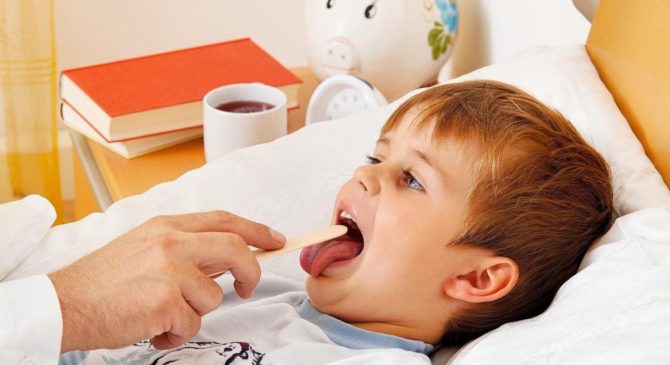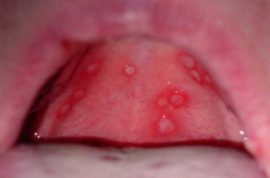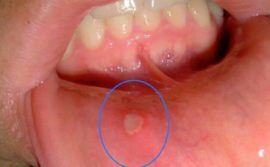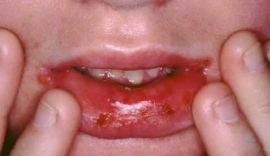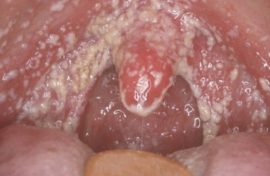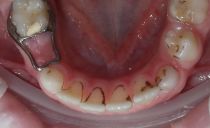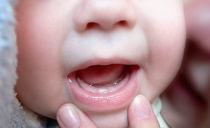Stomatitis in children and infants: symptoms, treatment, prevention
Stomatitis is an inflammation of the mucous membranes that cover the soft tissues of the oral cavity. The disease affects people of all age categories, but children are the first at risk. The baby's saliva contains a very tiny amount of enzymes with antiseptic properties, so its mucosa is vulnerable to pathogenic bacteria, microbes and fungi - the culprits of the inflammatory process.
The tactics for treating stomatitis in children depends on the totality of symptoms, the type of pathogen and associated pathologies that have caused the development of the disease. Therefore, therapy should be carried out under the strict supervision of a specialist. Self-medication is fraught with complications and the transition of ailments into a chronic form.
Content
- Types of disease
- Why does the disease occur?
- Common symptoms of the disease
- What does stomatitis in children look like: external signs and photos
- A child has stomatitis: what to do
- Therapy for aphthous stomatitis
- What can be done with viral stomatitis
- Treatment of fungal stomatitis
- Medications for bacterial stomatitis
- Stomatitis Prevention
Types of disease
Stomatitis is a generic name for pathology. Depending on the cause that provoked the infectious inflammation, it is classified into 5 main types:
- viral;
- bacterial;
- fungal;
- allergic;
- traumatic.
According to the depth of the mucosal lesions and the characteristics of the clinical picture, stomatitis in children is catarrhal, aphthous, erosive, vesicular, ulcerative. Most often, the patients of dentists are babies who suffer from inflammation of a viral, bacterial, fungal and aphthous origin. It is about them that the article will be discussed.
Why does the disease occur?
Regardless of the type of stomatitis, experts identify 3 common causes of its occurrence in children:
- weakness of the cells of the immune system;
- exposure of the thin mucosa to injury;
- non-compliance with hygiene.
The child’s immunity is not yet able to withstand many strains of bacteria, viruses and fungi that can get on the mucous membrane from the hands, grandmother’s lips during a kiss, a spoon or dummy licked by mom. In addition, some forms of the disease are contagious, and children love to share toys and usually do not have the habit of washing their hands after them.
The causes of the development of various forms of stomatitis in the mouth in children are presented in the table:
| Viral | The most common pathogen is the herpes virus, which is transmitted from parents or close associates. Acute herpetic inflammation most often manifests itself in infants from six months to three years, because they have not yet acquired immunity, and antibodies obtained with mother's milk are gradually destroyed. In 90% of cases, the disease proceeds in a latent form and does not bother the child, and only in 10% - in acute.
After the initial infection, the herpes virus remains in the body forever, so stomatitis can disturb the child constantly. Relapses occur under the influence of the following factors:
|
| Bacterial | Bacteria enter the mucosa during contact with animals, carriers, contaminated toys and other objects. Pathology can occur due to the use of unwashed fruits, non-compliance with oral hygiene, and the habit of biting nails.
Bacterial stomatitis often occurs when teething, since the child during this period pulls everything that comes under his arm into his mouth to alleviate unpleasant symptoms. Suffer from ailment and older children. |
| Fungal | The causative agent is fungi of the genus Candida. They belong to the class of conditionally pathogenic and make up the natural microflora of the oral cavity. Under ordinary conditions, microorganisms do not harm a person, but under the influence of certain factors, they are activated and provoke the development of the inflammatory process. These factors include:
|
| Aphthous | It differs noticeably from other forms by single rashes in the form of large, round aphthae. They are formed under the influence of the following factors:
|
Common symptoms of the disease
With stomatitis of any form, children are anxious, naughty, complain of pain in the mouth, refuse to eat. If you examine the mucous membrane of the oral cavity, you can find on it wounds, sores, purulent vesicles or single aphthae. Usually, rashes concentrate on the cheeks, tongue, palate, inner and outer lips.
Each form of stomatitis is characterized by individual signs of deterioration in the health of the child:
- With herpetic, the baby complains of headache, weakness and other signs of intoxication. By the end of the second day after the onset of the first symptoms of malaise, body temperature rises, which can vary between 37.5–41 ° C. Lymph submandibular nodes increase in size and hurt on palpation.
- With aphthous stomatitis, the child feels satisfactorily, but there may be a slight temperature, weakness and swollen lymph nodes. The same symptoms are characteristic of a disease of bacterial origin.
- Fungal stomatitis proceeds without an increase in lymph nodes in children, an increase in temperature. The kid complains of pain, burning and dry mouth. These symptoms become the cause of his restless behavior, refusal to eat, moodiness.
What does stomatitis in children look like: external signs and photos
Herpetic (viral) stomatitis
With herpetic stomatitis, the mucous membrane of the oral cavity reddens and swells. On the inside of the cheeks, on the lips, tongue, palate, bubbles appear the size of a grain of millet. Usually they are arranged in groups.
In the first stages of herpetic stomatitis, rashes on the mucous membrane of children are filled with a clear liquid. Within two to three days, it becomes turbid, the bubbles burst and form erosions of red color, which quickly dry out and become covered with a yellowish or whitish bloom.
Often, redness of the mucous membrane affects the edge of the gums, which resembles a gingivitis clinic.
Chronic herpetic stomatitis in a child is characterized by the same external manifestations as acute. The only difference is that the general condition of the patient does not suffer. That is, symptoms of intoxication are absent or close to minimal.
Aphthous stomatitis
With aphthous stomatitis, ovate or round aphthae appear on the mucous membrane. The size of the formations is 5–10 mm. The edges are even, surrounded by a red rim.
The surface of aphthae is covered with a grayish fibrinous coating. Rashes are painful on palpation and are formed in a single copy. Less often in double or triple.
In contrast to a herpetic ailment with aphthous, gingivitis symptoms are not observed.
Bacterial stomatitis
With bacterial stomatitis, the mucosa is covered with a coating of gray or yellow. In the foci of inflammation should appear vesicles filled with pus or bloody contents. The rashes have a rounded shape, a bright red hue, clear borders and elastic walls.
Dry layers in the form of yellowish crusts may occur on the child's lips. Gums swell and become painful. A putrid odor from the mouth appears.
This clinical picture lasts for one week. Then most of the symptoms disappear. However, do not rely on the fact that the ailment will pass by itself. Against the background of weak immunity, it undergoes chronicity, which is fraught with exposure of the alveolar bone.
Candidiasis stomatitis
Candidiasis stomatitis manifests itself in children by the formation of white or gray plaque, which covers individual sections of the mucosa and has a curdled consistency.
Candida stomatitis is localized on the gums, tongue, palate and inner surface of the child's cheeks. At an early stage of the disease, which is shown in the photo, plaque covers the mucous membrane with foci. And at the latter forms a continuous curd film.
Important! Do not confuse fungal deposits and breast milk after feeding the baby. Food deposits are easily separated from the mucous membrane, while fungal deposits are firmly attached, and the skin under them has a red tint and may begin to bleed.
A child has stomatitis: what to do
As soon as the baby shows signs of the disease, you need:
- To isolate it from the use of common cutlery and other household items. Separate individual towels, linens. If the baby has brothers or sisters, minimize its contact with them through common toys.
- Increase patient hygiene controls to prevent secondary infection and the development of more severe symptoms. In addition to regular brushing, it is recommended to use antiseptic agents. A one-year-old baby can be treated with a cotton swab dipped in a medicinal solution. And if a child older than 3 years has stomatitis, he can already rinse his mouth.
- Exclude spicy, sour, spicy foods from the children's diet. With thrush of the oral cavity, limit the amount of milk consumed by the baby.
- When the disease affects the baby, special attention should be paid to the treatment of the nipples, soothers, feeding bottles.
A child with any symptoms of stomatitis needs to be shown to a doctor, since it is almost impossible to cure the ailment on its own, and delaying treatment is fraught with the development of serious complications.
The tactics for treating stomatitis in children should include measures to eliminate the cause that caused the inflammation. Symptomatic therapy will only lead to a temporary improvement in the well-being of the baby, as the disease quickly becomes chronic.
Therapy for aphthous stomatitis
Since the disease often manifests itself against the background of an allergic reaction to products, you need exclude nuts, honey, strawberries, citrus fruits from the diet. If the baby is taking medication, it is necessary to consult a doctor about replacing the prescribed drug with a safer analogue.
Treatment of childhood aphthous stomatitis should include:
- Reception of antiallergic medicines. Antihistamines include Suprastin, Tavegil, Claritin and many others.
 Local processing of aft. In the early stages of the disease, antiseptic rinses with Miramistin solution and lubrication of the rashes with an anti-inflammatory gel with an analgesic effect are indicated. One of them is Holisal. After elimination of acute symptoms, the stage of treatment of the mucosa with epithelizing agents, for example, Solcoseryl gel, begins.
Local processing of aft. In the early stages of the disease, antiseptic rinses with Miramistin solution and lubrication of the rashes with an anti-inflammatory gel with an analgesic effect are indicated. One of them is Holisal. After elimination of acute symptoms, the stage of treatment of the mucosa with epithelizing agents, for example, Solcoseryl gel, begins.- The use of local immunomodulators. You can use toothpastes based on lysozyme, lactoferrin, glucose oxidase - enzymes that increase local immunity. Adolescent children are recommended to give the drug "Imudon", produced in the form of lozenges for resorption. It should be taken five tablets a day for two weeks.
- Sanitation of the oral cavity. One of the causative agents of aphthous stomatitis is staphylococcus, which is full of carious lesions and plaque. Therefore, dental diseases are treated before the start of drug therapy.
Physiotherapy is a good effect on the treatment of stomatitis in young children - irradiation of aft with UV rays. Referral to the treatment room may be performed by a pediatric dentist or pediatrician.
If the disease manifests itself often, an immunological examination should be performed. If this is not enough, then specialists such as an endocrinologist, gastroenterologist, and otolaryngologist can help identify the pathology that led to the development of chronic recurrent aphthous stomatitis.
What can be done with viral stomatitis
With severe symptoms, the child is hospitalized. With mild treatment at home is acceptable. Drug therapy may include both local and general effects:
 To reduce the inflammatory process, it is recommended to treat the affected tissue with decoctions of herbs - chamomile, sage. Or their mixtures. A cotton pad is moistened in a decoction and wiped wounds on the mucosa, as well as lips and the area around the baby’s mouth. Older children can use a rinse. The procedure is carried out several times a day.
To reduce the inflammatory process, it is recommended to treat the affected tissue with decoctions of herbs - chamomile, sage. Or their mixtures. A cotton pad is moistened in a decoction and wiped wounds on the mucosa, as well as lips and the area around the baby’s mouth. Older children can use a rinse. The procedure is carried out several times a day.- To treat the inflamed mucosa in the mouth in children who suffer from herpetic stomatitis is recommended by Viferon in the form of a gel or ointment. Its active substance - interferon alpha-2 - is famous for its pronounced antiviral and immunomodulating effect. Home remedies for the herpes virus are powerless.
- To eliminate unpleasant symptoms, the drug "Stomatodin" is prescribed - an antiseptic that has an antimicrobial and analgesic effect. It is recommended to use "Hexoral tabs" - lozenges.
- Stomatitis can be treated with antiherpetic ointment: “Zovirax”, “Acyclovar”, “Bonaphton”. With frequent relapses, the doctor will prescribe a prescription for antiviral drugs in tablets, for example, Acyclovir or Valtrex.
- To heal wounds using "Carotoline" - a solution. Or natural sea buckthorn oil.
- As antiseptics, drugs such as Lugol, Miramistin are used. Vitamin therapy is shown, which can be carried out with the help of “Imudon” absorbable tablets. At high temperatures, antipyretics are prescribed.
Attention! Medications can be given to children only on the recommendation of a doctor. Self-medication is dangerous to the health and life of the baby.
Treatment of fungal stomatitis
If the disease is provoked by Candida fungi, acid fruits, drinks, too hot or cold food should be excluded from the diet. Reduce the amount of carbohydrate products, spices, sweets.
You can treat children's fungal stomatitis with the following means:
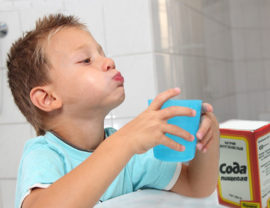 A solution of soda. 2 teaspoons are dissolved in 1 cup of water. substances. For babies, the mucous membrane is treated with a cotton swab, for teenagers - with rinses.
A solution of soda. 2 teaspoons are dissolved in 1 cup of water. substances. For babies, the mucous membrane is treated with a cotton swab, for teenagers - with rinses.- Ointment drug “Clotrimazole”, “Pimafucin” or “Candide”. All of these funds have a pronounced antifungal effect. It is important not to interrupt the course of treatment ahead of time, otherwise drug resistance will develop in microorganisms.
- A doctor may prescribe antifungal drugs in the form of tablets or suspensions to adolescent children. For example, Diflucan, Fluconazole.
Medications for bacterial stomatitis
The main component of therapy for bacterial inflammation of the oral mucosa is rinsing with antiseptic solutions. If the pathology is diagnosed in infants, rinsing can be replaced by irrigation. Many manufacturers produce drugs with special spray nozzles, as in the photo, which are designed for the comfortable treatment of stomatitis in children.
For the main therapy, antibiotics and local antiseptics are indicated. And for the prevention of disease and the prevention of complications - immunomodulators.
Most often, doctors prescribe the following drugs:
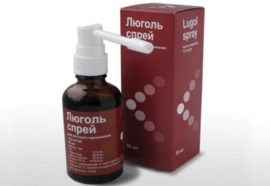 Spray "Lugol". Contains potassium iodide and glycerol. It is indicated for the treatment of stomatitis in children older than 5 years. The frequency of use is 5-6 times a day.
Spray "Lugol". Contains potassium iodide and glycerol. It is indicated for the treatment of stomatitis in children older than 5 years. The frequency of use is 5-6 times a day.- Semi-synthetic antibiotic Augmentin. It belongs to the group of penicillins and is prescribed for severe illness. The main active substances are amoxicillin and clavulanate. Method of release - powder for injection, tablets, syrup, suspension. The dosage is determined by the attending physician and depends on the age of the baby, the neglect of stomatitis and individual factors. The drug is contraindicated in children under 2 months of age.
- Gel "Metrogil Dent." Contains antibiotic and antiseptic, so it has a double effect. The tool can treat stomatitis in children older than 6 years.
Stomatitis Prevention
After the child recovers, you need to replace his toothbrush, pacifier, bottle in order to avoid secondary infection of the mucosa. If the baby has carious lesions, you need to visit the dentist to heal them and prevent the relapse from starting.
A huge role in preventing outbreaks of any kind of stomatitis is played by oral hygiene. Among other rules that contribute to prevention, there are:
- Washing hands before eating, after a walk, playing with other people's toys.
- The systematic use of vitamins and good nutrition.
- Keeping the house clean. Especially if there is a patient in it.
- The exception to the diet is strongly spicy, salty, sour, cold, hot food. Limited sugar intake.
- Healthy lifestyle. Spending time in the fresh air, playing sports is useful for strengthening the immune system.
If you detect the slightest signs of inflammation of the oral mucosa of a child, you need to consult a dentist. Determining the diagnosis by photo and treating children with stomatitis with their own selected drugs is not only useless, but also dangerous. And for health, and for the baby’s life.

